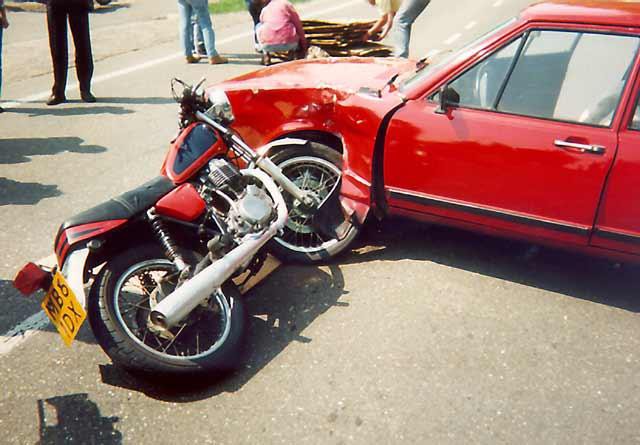Accidents of motorcyclists: some figures.
Research: MAIDS Report
In Europe, researchers have looked in detail at motorcycle crashes, and figures have been compared to figures of "average" motorcyclists (it should be noted that they included scooters and "light" motorcycles as well). This MAIDS-rapport outbound link is on-line (you have to register to get the full report, but it's free).
Some of the findings (we will relate to some of these figures in the items below):
1.- In 37% of cases, the primary accident contributing factor was a human error on the part of the motorcycle rider.
The human error could be lack of attention or lack of skill. The researchers note that often, the amount of skill needed exceeded the amount of skill that is needed to pass exams.
Obviously, since skills are the result of practice over time and the exams are at the beginning of the rider's experience.
2.- Among the secondary contributing factors, motorcycle riders failed to see the other vehicle and they also made a large number of faulty decisions, i.e., they chose a poor or incorrect collision avoidance strategy.
Moped riders tended to fail to see the other vehicle more than motorcycle riders, while motorcycle riders tended to make more faulty decisions.
In 13% of all cases, there was a decision failure on the part of the motorcycle rider (braking too late or too little, braking where outmanouvring would be better, freezing instead of manouvring, etc).
3.- In 50% of cases, the primary accident contributing factor was a human error on the part of a car driver.
Often, this has to do with not seeing (or not looking).
4.- In about 1/3 of accidents motorcycle riders and car drivers failed to account for visual obstructions and engaged in faulty traffic strategies.
This means, for instance, that they didn't realize there was a blind corner, or that a parked truck bloked their view.

5.- 90% of all risks to the motorcycle rider, both vehicular and environmental, were in front of the motorcycle rider prior to the accident.
This doesn't mean of course that you don't have to check your mirrors, but what is in front of you should be observed with great attention.
6.- Among the primary contributing factors, over 70% of the car driver errors were due to the failure to perceive the motorcycle.
This is the "Sorry I didn't see you" situation. In most cases, wearing highly visible clothes or carry fancy lights would not help: the car driver did not look at all, or the motorcycle was hidden behind the blind spots of the car.
7.- The roadway and cars were the most frequently reported collision partner. In 60% of accidents, the collision partner was a passenger car.
The roadway as "collision partner" of course, means that there was a one-sided accident, with only the motorcycle (or moped) rider involved. Ride too hard (with respect to ones capabilities) in a corner is for instance often a cause of these kind of accidents.
Passenger car here, means a car which is not a truck, bus or van: it doesn't mean that there were actually passengers in the car beside the driver.
8.- There were motorcycle technical problems in less than 1% of the accidents. Most of these were related to the tyres.
Meaning, of course, that you should regularly check your tyres for possible punctures...
9.- In 18% of all cases, motorcyclist's traveling speeds were greater than or less than the surrounding traffic and this speed difference was considered to be a contributing factor.
Note that the important factor here is the speed difference: both higher and lower speed than the surrounding traffic may be a contributing factor to an accident.
10.- 24.2% of accidents involved riders with less than six months experience..
Obviously: this cannot be avoided: one has to get that experience. But it shows that if you ride a motorcycle, it's important to keep doing it: don't ride once in a month, for instance.
11.- In general riders with more experience are less likely to be the primary contributory factor of an accident.
Of course, here the same applies as above.
12.- 29% of riders with less than 6 months experience had a skills deficiency and this percentage went down to 6.4% for riders with over 98 months of experience.
And again.
Site: lazymotorbike.eu
Весь мото мир в вашем смартфоне, мобильное приложение и социальная сеть для мотоциклистов. Присоединяйся к нам:
Download on theApp StoreDownload on theGoogle Play